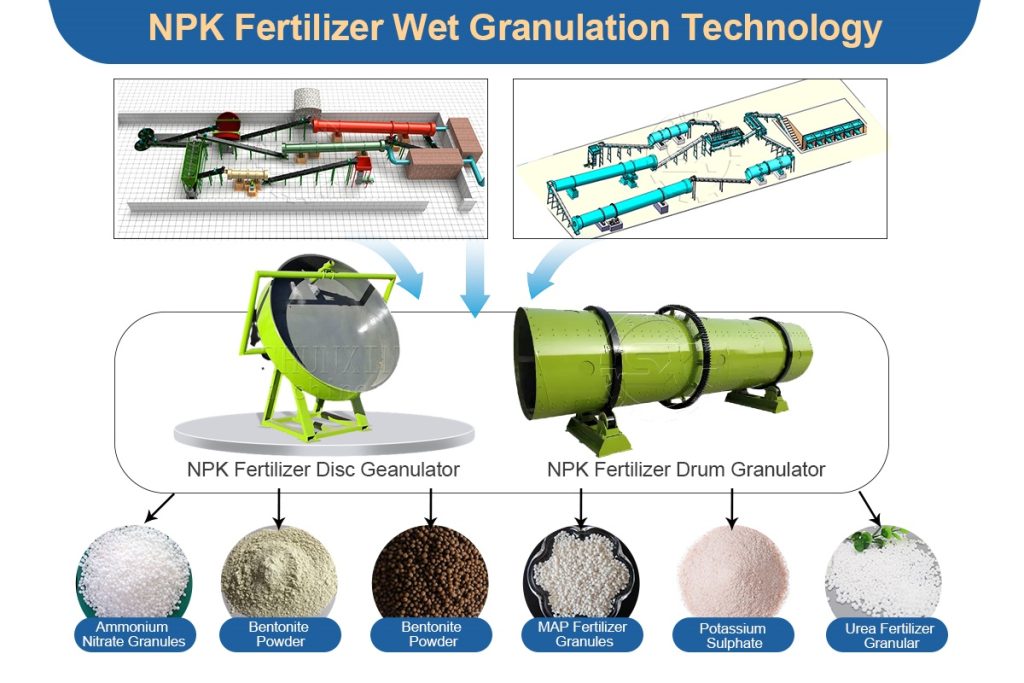An NPK fertilizer pelletizer plays a central role in determining overall fertilizer plant cost. When a company plans to build an NPK fertilizer production plant, the selection of the granulation machinery directly affects investment scale, operation efficiency, and return period. The pelletizing process defines the overall structure of a fertilizer manufacturing line because it connects raw material preparation, granule shaping, and finished product quality. The compound fertilizer plant cost depends not only on raw materials and utilities but also on the performance, automation level, and configuration of the pelletizing equipment. Therefore, understanding how an NPK fertilizer pelletizer influences fertilizer plant setup cost helps investors and producers make rational economic decisions and optimize resource allocation.
What Raw Materials Affect NPK Fertilizer Production Process and Cost?
Different raw materials have different impacts on NPK fertilizer manufacturing plant cost and equipment design. Common materials include urea, ammonium sulfate, ammonium chloride, potassium chloride, and monoammonium phosphate. Some producers also add trace elements such as zinc sulfate or magnesium oxide to enhance nutrient balance. Each ingredient shows unique physical and chemical characteristics, so the granulation process must adapt to its moisture, density, and solubility. For example, when a producer uses powdery urea or potassium chloride, the pellet forming rate in a drum granulator or disc pelletizer may vary, influencing output and energy consumption.

In addition, the choice of raw materials directly influences the configuration of related machinery. A stable batching machine ensures accurate ingredient proportioning, while a crushing machine prepares uniform particle size before granulation. The more consistent the feed material, the lower the energy requirement and product loss, thereby reducing total NPK fertilizer production plant cost. When a fertilizer factory uses materials with high moisture content, it also requires additional rotary drying and cooling equipment. These aspects show that raw material selection and machine matching closely relate to fertilizer plant setup cost and operational efficiency.
How Do Pelletizing Machines Shape Compound Fertilizer Production Line Investment?
The type and performance of the pelletizing equipment determine the capital scale of an NPK fertilizer production line. In most fertilizer plants, producers choose from disc granulators, double roller extrusion granulators, or drum pelletizers. Each granulation machine has distinct features, capacity ranges, and maintenance requirements. A disc granulator offers flexible control of granule size and suits small- or medium-capacity systems. A double roller extrusion pelletizer consumes less energy and produces uniform particles without drying, which lowers equipment investment and space demand. Conversely, a drum granulator provides continuous operation and high yield, suitable for large-scale compound fertilizer production, but it requires higher installation and maintenance costs.
The automation level of the pelletizing machine also influences fertilizer manufacturing plant cost. Advanced pelletizers integrate automatic feeding and dust collection systems, reducing labor cost and environmental treatment expense. When the pelletizer works together with a rotary screening machine and a packing machine, the whole production process becomes more streamlined. Consequently, the fertilizer factory cost depends not only on initial equipment purchase but also on long-term operation, maintenance, and energy use. The right pelletizer selection helps reduce total npk fertilizer production plant cost and ensures stable product quality.
Why Does the Pelletizer’s Efficiency Reflect Overall Fertilizer Plant Setup Cost?
A pelletizer’s output efficiency and granule strength determine the profitability of the entire NPK compound fertilizer production line. When the pelletizing process achieves a high granulation rate, fewer materials return for reprocessing, lowering energy use and transportation within the plant. Higher yield means faster turnover, which shortens the investment recovery period. A stable pelletizing section also minimizes downtime, improving the rhythm of the whole fertilizer manufacturing procedure.
Moreover, pelletizer efficiency affects auxiliary equipment requirements. For example, if the pelletizing system forms granules with consistent moisture and size, the drying and cooling load decreases, saving fuel and electricity. Well-designed granule shape also simplifies screening and packaging, thereby improving final product consistency and market competitiveness. Investors who focus on equipment compatibility and technological matching can manage compound fertilizer plant cost more effectively and enhance long-term sustainability.
Conclusion
An NPK fertilizer pelletizer strongly influences the financial structure and production performance of any compound fertilizer factory. Through careful raw material selection, appropriate granulation machine configuration, and balanced auxiliary equipment setup, producers can reduce fertilizer plant cost while maintaining product efficiency and quality. Considering all factors—from raw material preparation to pellet making and packaging—helps in designing a cost-effective fertilizer manufacturing system.
For enterprises seeking reliable solutions, cooperating with a professional fertilizer equipment manufacturer—Yushunxin ensures optimized NPK fertilizer production line planning, stable pelletizing performance, and competitive fertilizer plant setup cost for sustainable business growth. You can visit: https://www.fertilizerproductequipment.com/npk-fetilizer-plant-cost/